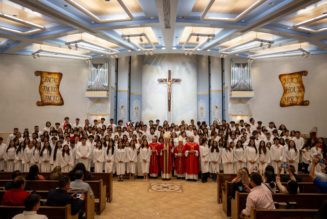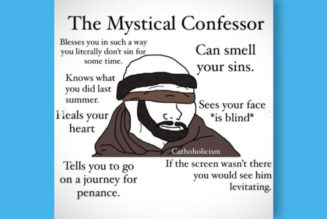
The feast of Mother Teresa, St. Teresa of Kolkata, has me thinking of the Synod coming up in a month — and about Katie and Emily.
In the wake of the Dobbs decision that overturned Roe v. Wade last year, I talked to women who had had abortions. One was Emily Johnston, who has spent years serving women who are considering abortion. She still grieves the two children she aborted, and works hard to spare others her fate — others like Katie.
Katie was scheduled to abort her child the day Emily called.
It would have been Katie’s second abortion. Like so many women I heard from, she felt like “I had no choice.” She was alone with her 5-year-old, abandoned by the father, and pregnant again. She called several organizations for help, and got only pro-life talking points and lists of more phone numbers.
But Katie didn’t need phone numbers. She needed accompaniment. She interpreted her encounters with those organizations this way: “They didn’t care about the women. They should care more about the women versus just telling you to choose life.”
That’s when Emily called. “She told me her story and she said, ‘I am going to be with you throughout the entire pregnancy.’ And she was with me every day, finding jobs, getting assistance. She was the emotional support I needed,” said Katie. She laughed, “Then it turned out Emily was pregnant too. We were pregnant together!”
When people talk about accompaniment and the Synod, I think of Katie and Emily. I also think of the Little Sisters of the Lamb, who live with the poor and go door to door in their neighborhoods. I think of our own Atchison community meals at St. Joseph’s church. I think of my wife, whose service is the only reason I have any credibility at all to talk about this. But most of all I think of Mother Teresa, who died on Sept. 5 26 years ago.
Mother Teresa is the G.O.A.T. — the “greatest of all time” — when it comes to accompaniment.
Some of us still remember Sept. 5, 1997, when Mother Teresa’s death pushed our sadness deeper as the world was immersed in a media-saturated grieving for Princess Diana, who died a few days earlier.
At the time, the desire to compare the two proved irresistible, but the comparisons never caught the true depth of what made Mother Teresa so different. Both women “accompanied” the poor, but one did it occasionally, from a distance. The other lived among the poor and gave them everything she had, including her time.
And something else was different, too: Princess Diana embraced the secular worldview of love as tolerance, a live-and-let live attitude that was neutral about faith and morality. Mother Teresa was a great saint, utterly devoted to Jesus’s Great Commission which demands we teach his commandments.
That made Mother Teresa the perfect saint for the 21st century — and for the Synod.
She is perfect for us because we detest hypocrisy, and she was far from a hypocrite. Mother Teresa lived her love for the poor to the point of personal exhaustion. Our age is skeptical about faith — but Mother Teresa kept her faith despite unimaginable spiritual and physical hardships. Our age exaggerates physical beauty. But Mother Teresa, with her wrinkled, leathery skin, is at the same time the most attractive and most conventionally unattractive “celebrity” face in popular memory.
Mother Teresa is also perfect for us because we love to identify people as the G.O.A.T. — the greatest of all time — and the more we learn about Mother Teresa, the more we discover that, even among the saints, she stands out. Intellectually, she was impressive. She spoke simply, but as a native Albanian born in 1910, she spoke English flawlessly. She was equally at ease with world leaders and with dying lepers as she managed an enormous worldwide network of apostolates.
But Mother Teresa is perfect not just for how well her character fits what we long for; but how she got that way.
We live in a time that detests suffering — we spend huge amounts of money to avoid it, to hide it, and to make it go away. Mother Teresa did the opposite: She embraced it, brought it out into the open, and entered into it.
In 1946, Mother Teresa wrote down the story of how Christ called her to go to India. She didn’t go gladly.
“How could I?” she said “I have been and am very happy as a Loreto Nun. To leave that what I love and expose myself to new labors and suffering, which will be great, to be the laughing stock of so many, especially religious, to cling and choose deliberately the hard things of an Indian life, to loneliness and ignominy, to uncertainty — and all because Jesus wants it, because something is calling me to leave all and gather the few to live his life, to do his work in India.”
And yet she went.
Father Brian Kolodiejchuk, the postulator of her cause said that her Yes was rewarded with a “real, close, intense union with Jesus in 1946 and 1947.” But then, once the Missionaries of Charity launched, she received the dark night of the soul that the great mystics had experienced: the agonizing feeling of the absence of God.
“Dark night” experiences lasted months or even years for the great mystics. Mother Teresa’s lasted five decades.
“This was for us a new way of understanding the ‘I thirst;’ of Jesus — and often Mother would speak of a ‘painful thirst,’” said Father Brian. “Mother was sharing in the longing and sufferings of her beloved.”
For five decades, Mother Teresa suffered everything Jesus suffers from those who ignore him and betray him: Five decades of feeling left alone. Five decades of feeling how terrible God’s absence is. And five decades through which the mere memory of her time of intense intimacy with Jesus carried her.
As all this was going on, she used to say that she wanted to be an “apostle of joy,” because she never forgot how powerful that closeness with Jesus had felt.
In private correspondence, Mother Teresa shared what Jesus told her during their months of intimacy before the dark night fell:
“You will suffer, suffer very much, but remember I am with you. Even if the whole world rejects you, remember you are my own and I am yours only. Fear not, it is I. Only obey — obey very cheerfully and promptly and without any questions. Just only obey. I shall never leave you if you obey.”
Her driving ambition in life was not to end suffering, but to console Jesus; to pick up her cross daily to follow the Lord by serving his people.
It was her closeness to the cross that made Mother Teresa the G.O.A.T. of accompaniment.
I pray that the Synod will look to Mother Teresa’s way of accompaniment. It’s the only way that works.
As Father Mike Schmitz put it recently, “We don’t love because we don’t have time to love. We are in too much of a hurry.” We don’t give Jesus the time we need to unite with him, and we don’t give the image of Jesus in our neighbor our time either, because we are too busy looking after ourselves.
Which brings me back to Emily and Katie.
Emily knew from experience that calling out the sin of abortion wouldn’t help Katie in her difficult situation. Seeing a priest carrying an “Abortion Is Murder” sign actually pushed Emily toward her own abortion, she said. But speaking to a priest taking time for her in the confessional would later bring her back to Jesus.
Pro-life messages didn’t help Katie either. Neither did sharing phone numbers; in her desperate state of mind she didn’t have the wherewithal to put her life back together. Pretending that abortion is okay is the easiest response of all — but Emily knew that only leads to years of sadness.
The only thing that helps is stopping what you are doing and spending lots of time knowing and loving another person, while staying utterly faithful to Jesus. And the only force that can motivate that is love, the love whose highest expression is the cross.
I pray that Mother Teresa will “accompany” us all, both those who are wary of the Synod and those who want radical doctrinal change from it. She lived “total welcome” with regard to the poor of any race, creed, or sexual orientation and “total obedience” with regard to the Lord.
God sent her to us to show us all — especially the Synod — that this is how to live.
Photo: Tim Graham, Alamy.



![Following UK Prime Minister Boris Johnson’s Catholic wedding, the task of announcing new Anglican bishops will fall to someone else [London Times paywall]…](https://salvationprosperity.net/wp-content/uploads/2021/06/following-uk-prime-minister-boris-johnsons-catholic-wedding-the-task-of-announcing-new-anglican-bishops-will-fall-to-someone-else-london-times-paywall-scaled-327x219.jpg)



